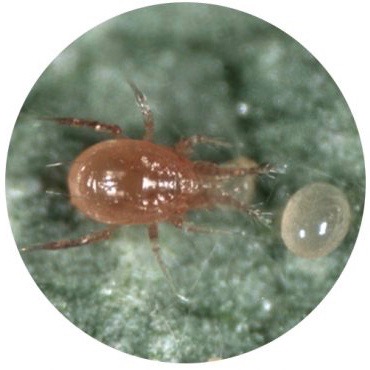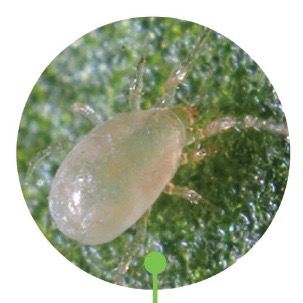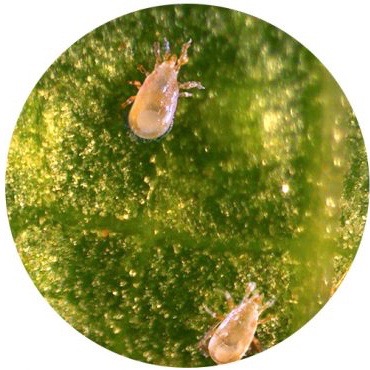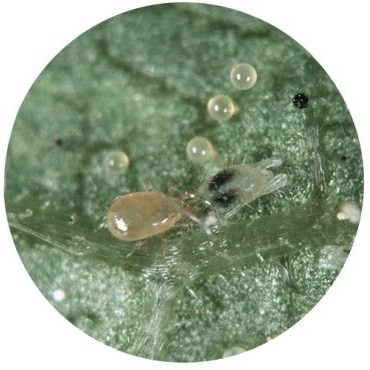Using predatory mites for cannabis is a great way to control pests in the grow room. Previously only within reach of large agricultural food producers, beneficial insects are now a reality for smaller, craft cultivators of cannabis. Like warriors to war, they create panic among pests when released and watching them consume their prey is something to behold.
Before you go drafting your troops though, there are a few things to note and species to be aware of. For example each type of predatory mite prefers slightly different climate and prey. Once your enemy has been identified, this guide can help you decide on which type of serviceman is best for the job.
Why Use Predatory Mites?
It’s no secret that so much of our food produced on mass, is tainted with “organic” or systemic pesticides. Very often the same can be said for cannabis. Personally, I have heard the words “Rose Care” uttered from the lips of cannabis growers way too many times and it’s got to stop.
All these chemicals and compounds are also impacting our planet. The use of predatory mites for cannabis removes the need to spray for pests, giving you a clean, safe product to consume. And a guilt free conscious too.
The last reason to use mites? Think of the story you’ll tell your mates about how you came to have your own army aiding you in your cannabis cultivation…as you burn a pesticide free phat one at the braai.
Predatory Mites Species
Each mite species has it’s own specialty. Here’s the types of predator mites for cannabis we like to use, which pests they target and their favored climates.
Phytoseiulus Persimilis

Background & Origin
When it comes to predatory mites, Phytoseiulus persimilis are the number one in fighting two spotted spider mites. Native to Chile, they are 0.5mm long, a red to orange colour and move fast seeking out their prey. They find their food in the wild through a distress signal put out by plants in the form of pheromones.
Target Pests
They feed only on the Two-Spotted Spider Mite at a rate roughly around 7 adult mites or 20 eggs per day. Usually when food is scarce, most will die of hunger or disperse.
Preferred Climate
Temps should be kept between 21–29°C. A relative humidity (RH) of less than 70% can stop nymphs from shedding their skin and moving on to become adults. An RH of 70-80% will give you the best chances of success.
Amblyseius Swirskii

Background & Origin
Originating from the east Mediterranean, A. Swirskii is often used in combo with other mites. Normally when crops are infested with more than one pest. They are less than 1mm in length, usually white in color, but that can change depending on their diet.
Target Pests
They feed on eggs and larvae of Thrips and Whitefly. Able to eat pollen, they can survive for a while when food is less abundant.
Preferred Climate
A. Swirskii prefer temps between 20-30°C and a relative humidity of 60% or higher. Should humidity drop acutely, mites will not be able to survive for long.
Neoseiulus Cucumeris

Background & Origin
Found across Europe, Neoseiulus Cucumeris is a generalist predator. They can be between 0.5-1mm in length and range from clear to pink to tan depending on their last meal. They are hardier than some of the other mite species and come with some skills.
Target Pests
They can help control thrips but do also feed on certain mite species. Their first but not unusual party trick is to be able to live on pollen when pests are scarce.
Preferred Climate
Can thrive in slightly harsher conditions of 15-35°C with a relative humidity of 60% or higher. Their party trick is the ability to over-winter, or diapause as it’s also known. This means that mites and eggs stop developing during adverse climates, only to resume once conditions return to preferred ranges. Adults and nymphs will hibernate under mulch or organic matter on top of the soil.
Neoseiulus Californicus

Background & Origin
The name says it all as these mites were first noticed on Californian lemons in the 1950’s. Also found in Florida, South America, parts of Europe, Japan and even South Africa. Pear shaped, Californicus is under 1mm in length and vary in color ranging from clear, white, peach, pink and tan.
Target Pests
Two Spotted Spider Mites, Broad Mites and Thrips are all on the menu for californicus. They will eat up to 5 pest mites per day each. Their special skill is to survive well on pollen or thrips if around until their main prey’s numbers rise again.
Preferred Climate
Californicus are able to withstand lower levels of humidity if temps aren’t too high. Likewise they can survive slightly higher temps with higher levels of water in the air. They prefer temps between 16-30°C and an RH of 60% or higher. In general Californicus is a good option for slightly harsher conditions.
Transeius Montdorensis

Background & Origin
One of our favorite mites, survivors with a big appetite. Montdorensis is also one of the fastest to multiply going from egg to adult in only 7 days when conditions are right. They are pale and pear shaped under 1mm long.
Target Pests
Juveniles and the eggs of whitefly and thrips are not safe around Transeius Montdorensis who will eat more pests on average than Swirskii. Also able to live on pollen when food is scarce.
Preferred Climate
Montdorensis need temps between 20-30°C to do well and keep numbers. When conditions are right, we’ve seen them on our plants up to 4 weeks after release. Keep humidity levels above 60% and you’ll have many new mites to protect your plants as they breed.
How To Release Predatory Mites
Release your predatory mites for cannabis as soon as possible. Larger ones will get hungry and cannibalize on smaller mites if release is put off for too long. The mites we supply are in vermiculite substrate and packaged in tubes or bottles depending on numbers.
Lay the tube flat and gently roll to evenly distribute mites inside.
Sprinkle the medium with predatory mites over the top of the affected plants’ leaves and general canopy.
Do not sprinkle the vermiculite medium over flowering cannabis! You’ll have buds tainted with vermiculite that will never come out. Bug boxes that hook onto the stem are used instead.
We discovered most mite species have the instinct to climb. For flowering cannabis in our own grows, we sprinkle a small amount of mite containing media at the base of each plant. Mites then climb up the stem in search of food.
Conditions for release are also key. Cooler temps like early morning or late afternoon are perfect. This allows time for predatory mites for cannabis to adapt to their new home.
Release predators in hot spot areas where pest numbers are high. When adjacent plants leaves overlap, mites can easily spread across a canopy covering large distances in search of food.
Using Predatory Mites
One thing to keep in mind is that predatory mites for cannabis are live animals. Possibly placed in a habitat that may change from what they need to survive. Numbers will drop fast If conditions are not within range. Release mites regularly to sustain numbers over a period of time and increase efficacy.
Most mites will also happily consume the eggs of another predatory mite species. All they see are eggs from a species that isn’t their own.
As some species will live on pollen, cultivators grow perennial flowering plants to aid beneficial insect numbers. We’ve found a basil called Clove or African basil (ocimum gratissimum) that produces pink flowers year round to be a winner. The white basil known as Camphor or Kilimanjaro basil (ocimum kilimandscharicum) will also work but we are yet to try it. Both can handle the higher temps of a greenhouse in summer. They are also perfect for the garden attracting bees, hover flies, lacewings, predatory wasps and other beneficials.
It kind of goes without saying that predatory mites are not compatible with many pesticides and insecticides. Sulphur and pyrol products will kill most beneficials. Products like neem and soft soaps have varying effects where an acceptable percentage of beneficials could survive. Fungi’s used to control pests like Bavaria Bassania and Metarhizium Anisopliae have varying effects. According to some experts, Metarhizium has no effect on beneficials. There’s even research currently underway on how these fungi’s are taught by plant’s which insects to kill and which to leave alone.
If you’re unsure, feel free to get in touch for some advice before applying any predatory mites or pesticides.
How Many Mites Do I Need?
Andre, insect importer from Field Bugs says “5000 mites is enough to preventatively control an indoor area of 100 square meters. If pests are present and numbers are higher, doubling the quantity of mites for that area is necessary.”
Andre continues to say that “It’s advised to release beneficial insects on a regular basis to sustain their numbers. If you can provide food for them and the correct climatic conditions, they can develop into a healthy, somewhat permanent population.”
He has a warning though as “one of the biggest mistakes people make using beneficial insects, is using pesticides and chemicals after their release. Give them some time, monitor pest presence and like before, release beneficials more than once.”
Conclusion
The use of beneficial animals in agriculture dates back millennia. Like bees that handle our crop pollination, there’s no reason why we can’t let insects take care of pests for us too. It’s fighting nature with nature and with proper planning, the right nature will win in the end.
One only needs to look at our water ways, wetlands and dams to see all the things we’ve been spraying on our crops and working in the soil. By using predatory mites for cannabis as pest control, we can ease the pressure we put on our planet, and drool with awe as we watch them wipe out the enemy.
So next time someone asks if you have an IPM program, tell them you mite.
Order Predatory Mites here.



0 Comments